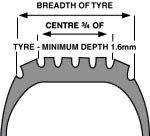UK Tyre Laws
Having illegal tyres on your vehicle can result in a fine of up to £2500 and 3 penalty points per illegal tyre. To avoid fines, penalty points and to ensure safety you mush make sure all your tyres are within the UK regulations.
There are various regulation that cover UK tyre law.
- 1. Regulation 24 - Indicates the types of vehicle covered and also temporary use spares
- 2. Regulation 25 - Details tyre loads and speed ratings
- 3. Regulation 26 - Stipulates the requirements for tyre mixing
- 4. Regulation 27 - Details condition and Maintenance of Tyres
These regulations state the following:
Tyre Tread Depth
Tyre tread must have a depth of at least 1.6mm over ¾ of the tread around the complete circumference.

Tyre Pressure
This regulation states that each tyre must be inflated to ensure they are fit for use.
Tyre Mixing
Vehicles must not be fitted with radial tyres on the front wheels and cross ply tyres on the rear tyres. Further more it is illegal to have a cross ply tyre on one side with a radial on the other.
Tyre Cuts
Tyres are deemed illegal if a cut in excess of 25mm or 10% of the tyre width and has reached the ply or cord exists. Any tyre cuts or damage that exposes the cords are illegal.
Unsuitability
A vehicle must be used within the fitted tyres load index or speed rating.
Temporary Tyres
All tyres that are marked temporary are restricted to 50mph.
EU tyre labels start being rolled out
New tyres will start to be sold with a label attached to them which is intended to help guide drivers on how safe, fuel efficient and loud they are.
There are roughly 300 different brands of tyres on sale in the UK, and they vary widely in how well they perform on the road.
An EU law means manufacturers will have to start fitting the colour-coded stickers - similar to those found on new fridges - in a bid to help drivers.
They are compulsory and should be on every tyre.
BBC transport correspondent Richard Westcott said the choice of tyres was bewildering to many motorists.
Our correspondent said: "Your tyres are the only thing connecting you and a tonne of metal to the road, yet many drivers have no idea which type to pick when they need changing."
The new sticker are designed to grade:
- How good the tyre is at stopping in the wet
- How fuel efficient they are
- How much noise the tyres make
Our correspondent said: "The safest tyres will stop you three car lengths quicker than the worst performers.
"While the best performers on fuel efficiency could save consumer nearly £100 a year on your fuel bill."
In 2012 the European Union will introduce a new tyre label, in order to provide standardised information on 3 specific performances; fuel efficiency, wet grip and external rolling noise. Tyre labelling for passenger cars and light trucks will take effect as from November 2012 for tyres on sale in the EU under European Regulation (EC/ No.1222/2009). The label must be accompanied on the actual tyre and will give consumers useful information to assist them when purchasing new tyres. On the left you can find an example of the new EU tyre label. These graphics on the label may be similar as those already used for household appliances and more recently new cars.
Fuel efficiency (Rolling resistance)

Rolling resistance is one of the main resistive forces on a vehicle, which acts as an opposite force to the direction in which the tyre is rolling. The rolling tyre deforms and dissipates energy. The tyre whose rolling resistance is greater, requires more fuel to move the vehicle forward. Therefore rolling resistance influences fuel consumption and the environment directly. On the top left of the label, this shows 7 classes which range from A (most efficient ) to G (least efficient), the grading indicates the tyre’s contribution to fuel efficiency and CO2 emissions.
Wet grip (Braking performance)

Wet grip is one of the most important safety aspects of a tyre. The tyres with excellent grip in wet surfaces have shorter braking distance when driving in rainy weather. There is a lot of other important frameworks which are also related to safety. However, consumers will be able to check and select for themselves their preferred performance. On the top right of the label, wet grip is also expressed in classes ranging from A (highest performance) to G (lowest performance).
External noise

Traffic noise is a major factor of nuisance and a very relevant environmental issue. On the lower part of the label, this indicates the level of exterior tyre noise from the vehicle (not the internal noise heard by the driver ), expressed in decibels. The grading indicates the tyre’s contribution to traffic noise and the environment. The label displays sound waves and corresponding levels ranging from 1 (least noise) to 3 (highest noise)
- 1 sound wave The best noise level performance. (3 dB below the future European limit*)
- 2 sound waves The average performance. (Already compliant with the future European limit*)
- 3 sound waves The weakest performance. (Compliant with the current European limit)
* The new European tyre external noise levels will be introduced by 2016.
24hr Mobile Tyre Fitting
We offer an emergency mobile tyre fitting service 24 hours a day. Call us on:
- 01903 202140
- 01903 786464
- 07928 078332
After 5pm and at weekends (call out charges may apply)
Why Choose Us
- Unbeatable prices
- New Tyres
- TPMS
- The very best brands
- Tyre fitting at garage
- Tyre fitting at home or workplace





 .
.














